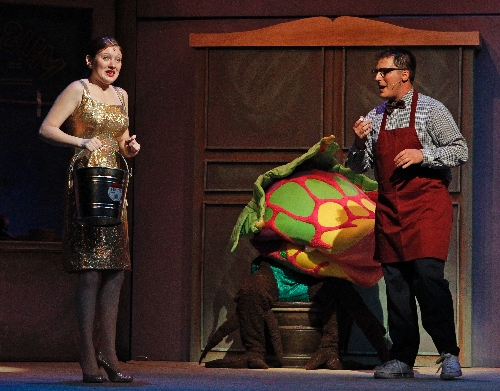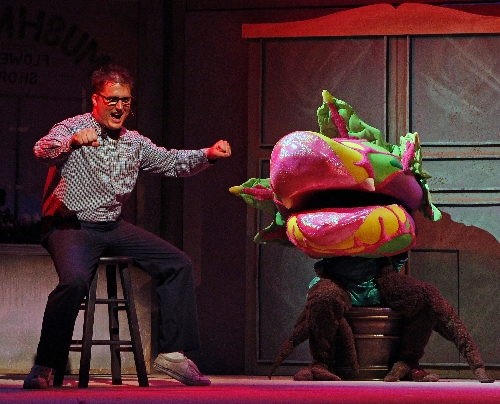Man-eating plant Audrey II searches for food in “Little Shop of Horrors”


Feeeeed me … the underlying meaning, social significance and cultural insights of "Little Shop of Horrors."
Don’t believe there’s underlying meaning, social significance and cultural insights to be gleaned from a musical about a Venus’ flytrap that guzzles blood and swallows humans?
Whaddaya, uneducated?
"My goal is to give it a little more depth," says Erik Ball, director of Signature Productions’ interpretation of the camp 1982 musical. That’s the one in which the grisly appetites of the aforementioned flytrap, i.e. "Audrey II," interfere with the romance of our hero and heroine, Seymour and Audrey, laboring at dead-end gigs at Mr. Mushnik’s Skid Row Florists.
"The elements and avenues the characters go down, they’re very relevant and personal to everybody, the whole idea that everyone hopes and dreams for something more."
Premiering with preview performances next week at the Summerlin Library Performing Arts Center, "Little Shop" is the cult fave that morphed from Roger Corman’s schlocky 1960 movie (with an appearance by pre-stardom Jack Nicholson as a masochistic dental patient) to the stage musical to a movie musical (featuring well-established Steve Martin as the sadistic dentist).
Composed by Alan Menken and Howard Ashman, the early rock/doo-wop/Motown-ish score includes the title tune, "Skid Row," "Somewhere That’s Green" and "Suddenly, Seymour."
Declares Ball: "I don’t think you can consider yourself a true fan of musical theater unless you love this show." Or, for that matter, a sociological sage. To wit:
Several eggheads — sorry, pop-cultural scholars — insist that beyond the obvious theme of poverty as Seymour struggles to get by on skid row, "Little Shop of Horrors" is a reflection of the integration issues between blacks and whites in the 1950s and ’60s, particularly the latter’s anxiety over it.
Audrey II, so the argument goes, is, in its vocal stylings, obviously African-American, and a menace to our white good guy, Seymour. In its satire of 1950s sci-fi flicks and the embrace of that era, "Little Shop’s" R&B-style soundtrack could be construed as a danger to the Pat Boone-flavored safety of white musical tastes.
Not sociologically trenchant enough? Try this theory from the "Horror"-rati:
"Little Shop of Horrors," at least in its 1980s incarnations, is a mirror of Tricky Dicky Nixon and his corrupted/interrupted presidency, which crashed with the Watergate scandal in 1974.
How? This doctrine holds that while Nixon viewed himself as a president determined to accomplish good things, his actions were unethical and created a rat’s nest of crime, similar to Seymour’s descent as he gains fame as the plant’s caretaker and affection from Audrey.
Believing he is rescuing Audrey from her abusive boyfriend, Seymour feeds the leather-clad creep to the ravenous plant, then must do likewise to Mushnik when the shopkeeper threatens to drop a dime on Seymour for the first death.
Or take "Horrors" at its surface meaning: As Seymour grows famous, he mistakenly believes Audrey loves him for his fame (she really loves him for him), reinforcing the eternal lesson that a craving for celebrity and success can cost us too much in terms of character.
Can we make a suggestion here? Why not pair "Little Shop of Horrors" with "Sweeney Todd" — a man-munching plant and a throat-slicing barber — for a double bill of Grand Guignol musical theater? Anyone wanna go halfsies with Signature? Just a thought.
Perhaps we’re getting too grandiose. Maybe we need to sweep away the pretense, as does Aelwyn Thomas, who portrays Audrey in this production. "The reason I tried out for this show is because my dad made me," she says. "It was the first show I was ever going to do outside of high school. I was more willing because it was this particular show." Knock ’em (if you’ll excuse the expression) dead, Aelwyn.
Let’s pare this show’s appeal down to what Michael Vojvodich — portraying Seymour, except for three performances when he hands off to Nicholas King — calls it: "It’s morbidly happy," he says.
Let’s focus on the technical achievements of "Little Shop" in this production, which features an almost 8-foot-tall puppet as Audrey II, with a convenient method of digestion.
"The puppet is built in such a way that it has the equivalent of a slide," Ball says. "When they get fed, they go down the esophagus, if you will, and slide right backstage." Cool. Hope the puppet doesn’t get indigestion, though.
It’s eating actors, after all.
Speaking of which, let’s know that certain touchstones of "Little Shop" remain, especially regarding Audrey II’s post-meal signature. " ‘A Little Shop’ without burping is a sin," Ball says. "We need to have an after-dinner burp."
Let’s reassure Mom and Dad that even though "Little Shop" is, well, a shop of horrors, Signature still specializes in family-appropriate entertainment. "It can be attended by all ages," Ball says. "Scary elements were made more thrilling than scary. Gruesome elements are more suggestively gruesome with shadow play, lighting and sound effects."
Let’s applaud Signature for attaching a food drive to "Little Shop of Horrors," challenging audience members to bring a canned good for the "Feed Me, Seymour" campaign — cast and crew will do likewise every night of the run — with a goal of collecting 200 cans per night, to be dispersed to several local charities.
Above all, let’s remember that "Little Shop of Horrors" is about global warming, the debt ceiling, Michelle Obama’s fab fashion sense, the troubled childhood of Moammar Gadhafi, Speaker of the House John Boehner’s tear ducts and Lindsay Lohan’s addictions.
Or not.
Contact reporter Steve Bornfeld at sbornfeld@ reviewjournal.com or 702-383-0256.
Preview"Little Shop of Horrors"
Preview performances 7:30 p.m. Monday, Thursday, July 29
Regular performances July 30-Aug. 27
Summerlin Library Performing Arts Center, 1771 Inner Circle Drive
$15-$23 (878-7529;
signatureproductions.net)












